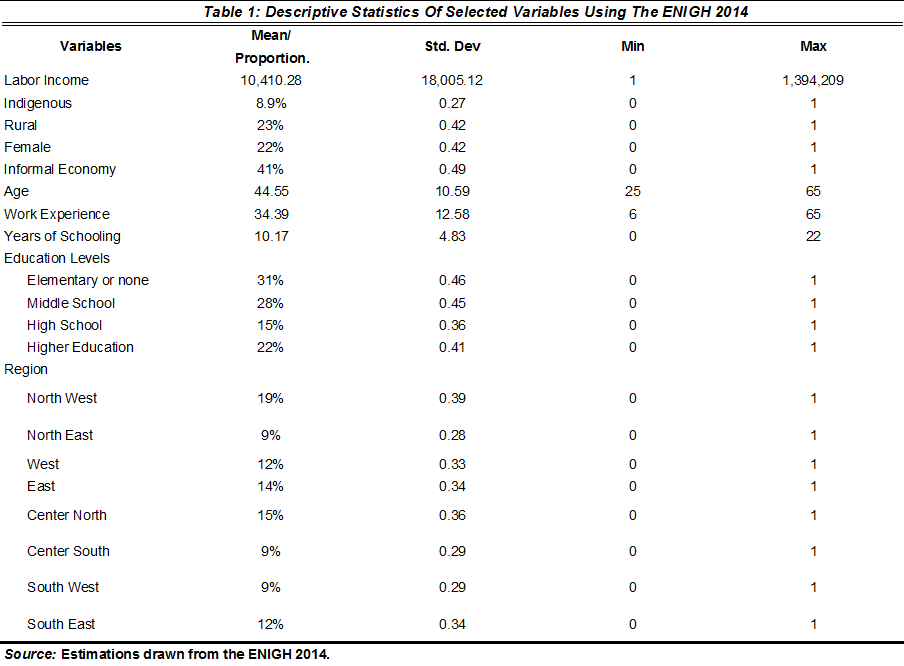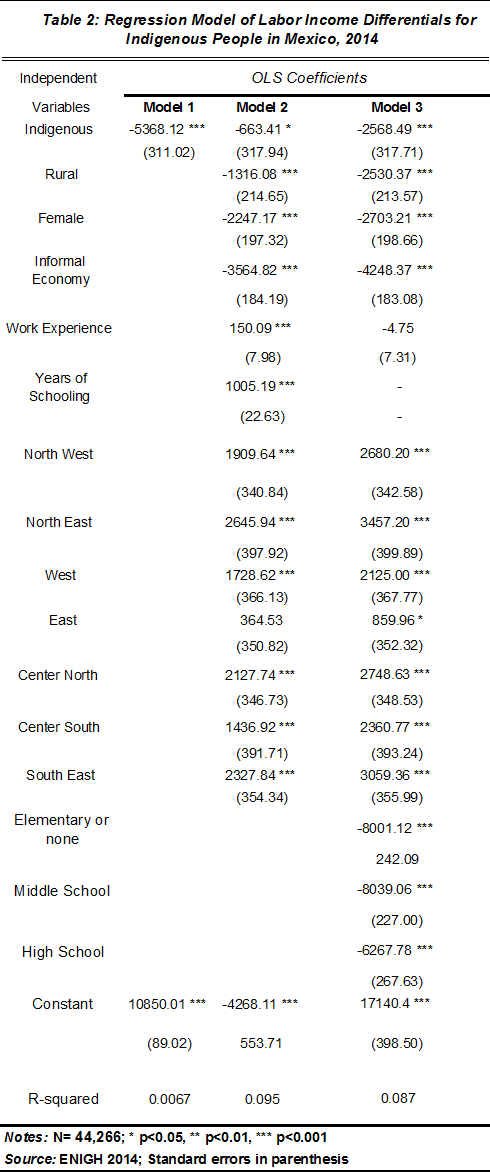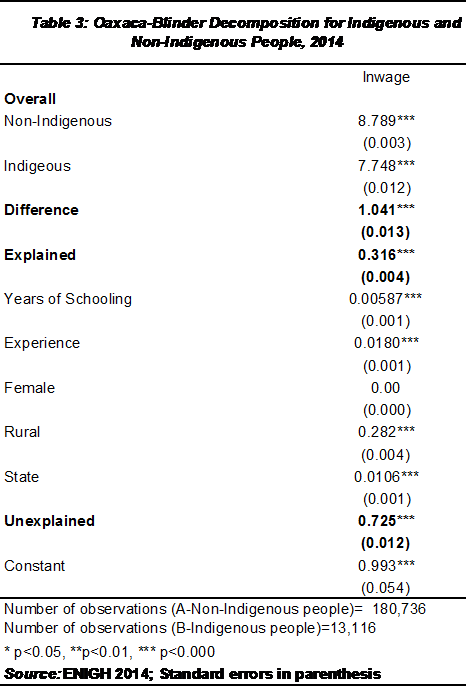Edited by Shreya Bhardwaj
Worldwide, indigenous peoples are among the most vulnerable and marginalized. This is particularly true in Mexico, where disadvantages faced by indigenous peoples are well documented. In Mexico, the indigenous population has historically faced higher levels of deprivations than non-indigenous people. While indigenous peoples account for a small percentage of the country’s total population–nearly 10 percent–the National Council for the Evaluation of Social Development Policy (CONEVAL, by its Spanish acronym) estimates that the percentage of indigenous people who live in poverty in Mexico is nearly double that of the general population: 76.8 percent versus 43 percent, respectively. In this context, the present article aims to analyze labor income differences between indigenous and non-indigenous people in Mexico to understand the factors that are causing the earnings disparity and to suggest effective public policy interventions that could help bridge this gap.
The indigenous concentration of poverty and inequality is increasingly being recognized in development literature (Sandefur & Pahari, 1989; Psacharopoulos & Patrinos,1994; Wilson & Mcdonald, 2010; Liberato et al., 2006; García-Aracil & Winter, 2006; and Atal et al., 2009; among others). Scholarly research in Latin America has observed a tendency for indigenous people to report lower labor market earnings and to experience higher levels of poverty. Psacharopoulos and Patrinos (1994) were the first to explore differences in ethnic groups’ living conditions among Latin American countries, finding a significant gap between the living conditions of indigenous people and those of non-indigenous people, as well as a positive correlation between being indigenous and living in poverty.
Navarrete (2005) contributed to the study of poverty from an ethnic perspective in Mexico using the Mexican Family Life Survey (MxFLS). His results indicate that indigenous people face greater difficulties in escaping poverty, particularly due to the socio-economic disadvantages they experience: these include lower schooling levels, lack of adequate infrastructure, labor discrimination, and vulnerability to natural disasters. Following Navarrete (2005), Atal et al. (2009), González de Alba (2010), and García-Moreno and Patrinos (2011) have found evidence of a significant indigenous earnings gap in Mexico.
While most empirical studies uphold that a great share of the gap in earnings can be explained by indigenous people’s lack of representation in high-paid occupations, the empirical literature in Mexico has been rather limited in the study of income disparity between indigenous and non-indigenous people due to labor market discrimination. The present study seeks to analyze the main observable factors that determine the indigenous gap in labor earnings in Mexico to help understand whether there are other inobservable factors, such as discrimination, that could explain this disparity. Understanding the underlying causes of this disparity is crucial for the design of effective public policies to bridge the gap in living conditions between indigenous and non-indigenous people.
Why Indigenous People in Mexico Lag Behind?
Labor market earnings differences among indigenous and non-indigenous people can be mainly attributed to the spatial segregation of indigenous communities. Most of Mexico’s indigenous people live in small communities–most of which are located in the poorer southern states. Most of these remotely located areas lack basic infrastructure such as roads, sewage and electricity systems; this isolation prevents indigenous people from attaining higher levels of education, receiving health care and social security services, accessing credit from financial institutions for self-employment, and entering well-paid jobs. In addition, the poor quality of education in those communities–due to the lack of teachers and adequate spaces for learning–affects the returns on schooling for indigenous people.
One well-explored factor contributing to this pattern of poverty and marginalization among ethnic minorities is that indigenous people, on average, demonstrate fewer desirable human capital characteristics, like knowledge, skills, and professional experience. Parker et al. (2002) show that, in Mexico, even when both indigenous children and non-indigenous children reside in highly-marginalized rural areas, the indigenous children on average fare worse in educational outcomes (years of schooling and educational performance) than the non-indigenous children. This disparity in education levels carries into adulthood occupational outcomes, as indigenous people’s low levels of education consequently prevent them from entering higher-paying skilled jobs. Furthermore, to date, the illiteracy rate for indigenous people is significantly higher than that of the national average (27.2 percent compared to 5.4 percent).
Another possible reason for the gap in indigenous and non-indigenous people’s labor earnings could be simply related to Mexico’s informal sector. Often, the livelihoods of indigenous people depend on traditional occupations, such as farming, hunting or fishing, and craft production. Such activities rarely take part within the Mexican formal economy. In addition, when looking for paid work, indigenous people are often confined to jobs in the informal economy (domestic work, street vending, construction and agriculture, among others). Thus, indigenous people are overrepresented in the informal sector, remaining outside the reach of established labor laws and hence earning lower wages.
A final explanation for the labor market income gap between indigenous and non-indigenous populations could be due to non-observable factors, such as labor market discrimination. This study employs both a linear regression model and a Blinder-Oaxaca Decomposition technique to answer the following question: If differences in human capital characteristics and other observable characteristics were removed, would non-indigenous people still earn more than indigenous people in Mexico?
Data and Methods
This article analyzes data from the National Household Expenditure Revenue Survey (ENIGH) 2014, the leading survey of Mexico’s National Institute of Statistics and Informatics. The ENIGH is uniquely suited for this study for several reasons. First, the ENIGH is the official source of data for income inequality and poverty measurements; it is the same data source CONEVAL uses for its poverty measurement. Second, since its 2008 edition, the ENIGH has included a question about indigenous language, allowing for identification of the indigenous population. The unit of analysis of the ENIGH is the household, but observations correspond to everyone surveyed within the household.
For this article’s analysis, the key or focal independent variable is the indigenous variable. The dependent variable in the study is respondents’ household labor income. The average monthly household labor income for the sample is 10,410 pesos. Since the survey is conducted at the household level, the sample was restricted to household heads to capture only those individuals whose income is reflected by their labor market earnings. In addition, the sample was also restricted to individuals aged 25 to 65 years—the working age population in Mexico. Finally, the sample is limited to those individuals who reported a positive household labor income.
The descriptive statistics for this study are presented in Table 1. The data set employed in this study consists of socio-economic and demographical variables for 44,266 observations for 2014.

The first step to assessing the relationship between the key explanatory variable, indigenous, and the dependent variable, labor income, will consist of the following OLS regression model:
laborincome=β0+β1indigenous+β2female+β3rural+β4informal sector+β5years of schooling+ β6work experience+ β7region+u.
The model includes two additional independent variables, years of schooling and years of work experience, that measure an individual’s human capital characteristics to control for the mainstream predictors of labor market income. The years of schooling variable was constructed by multiplying the level of education achieved by the number of years that are required to complete that specific education level. Years of work experience is not available in the ENIGH database, but for the purposes of this model the potential work experience has been considered as the difference between an individual’s age (in years) and that individual’s level of education (years it takes to complete the education level achieved). Since the variable age is correlated with the newly created variable work experience, it has not been included in the model.
Controls are added for gender, rural localities, and wage differentials between the formal and the informal economy. The model also includes regional differences in labor market wages that could potentially explain income differences among indigenous and non-indigenous people. The model is then expanded to include control variables for each category of education level achieved.
A second step is to employ a statistical method known as the Blinder-Oaxaca Decomposition to understand which factors are associated with the labor income gap between indigenous and non-indigenous people. This technique decomposes differences in mean outcomes between two groups; in this way, it analyzes differences that can be explained through the endowments of income-generating characteristics and those that cannot. Thus, by implementing this technique the model evaluates what would happen if indigenous people were to have the same human capital characteristics as non-indigenous people to assess whether there are effects of group differences in unobserved predictors that indicate that indigenous people experience discrimination.
Findings: Indigenous Labor Income Differentials
Consistent with the empirical literature, this study shows strong bivariate associations between being indigenous and having lower levels of labor income. Results indicate that differences in human capital characteristics–mainly years of schooling and years of work experience–as well as income gaps in other observed factors such as gender, rural versus urban areas, the informal economy, and economic differences among regions, explain a significant proportion of the labor income gap between indigenous and non-indigenous people in Mexico (see Table 2). Nevertheless, findings also suggest that some differences in earnings among indigenous and non-indigenous populations cannot be explained entirely by the observed characteristics included in this analysis.

Results from the Blinder-Oaxaca Decomposition indicate that unobserved factors play a significant role in explaining the indigenous labor income gap (see Table 3). The model presented below indicates that only 30 percent of the earnings difference can be explained through variation in the characteristics included in the model. While these results are higher than those previously obtained by Navarrete (2005), these findings provide additional evidence that numerous non-observable factors (e.g. language barriers, quality of education received, cultural differences and lack of social networks), and possibly discrimination, explain a significant proportion of the earnings disparity between Mexico’s indigenous and non-indigenous populations.

Conclusion and Policy Implications for Closing the Indigenous Gap in Mexico
The findings of this study are twofold: On the one hand, there is evidence of significant earnings disparities between indigenous and non-indigenous people in Mexico that can be attributed to human capital and geographical differences. On the other, the Blinder-Oaxaca Decomposition by ethnicity shows that unobserved factors account for a significant proportion of the indigenous earnings gap in Mexico, indicating that indigenous disadvantage would persist even if human capital outcomes were to improve for this population subgroup. These results highlight the need for both social policies that improve equal accumulation of human capital and an institutional framework that better addresses indigenous rights.
Labor discrimination is often rooted in social prejudice. As was previously pointed out, structural and cultural factors influence, in a decisive way, the working conditions of the indigenous population in Mexico. While it could be that labor market discrimination is fueled by differences in human capital characteristics, government policies in Mexico are designed exclusively according to the belief that ethnic discrimination has its roots in the precarious living conditions of the indigenous population: the policies seek only to reduce poverty outcomes by improving equal access to education and training, ignoring the need for further awareness on indigenous peoples’ rights.
If we want public interventions to be more effective at improving indigenous peoples’ living conditions, assistance programs should tackle this issue as an intricate phenomenon and promote the harmonization of the indigenous rights framework with the implementation of social policies. This could be achieved through the participation of indigenous communities and people in the planning and management of their own community development, ensuring respect for their rights as well as the recognition their cultural heritage.
For example, a key element in improving the impact of social policies aimed at improving educational and labor outcomes for indigenous people while advancing their rights is to adjust Conditional Cash Transfer (CCT) programs, such as Prospera, to suit the particular needs of indigenous communities. CCT programs like Prospera have proven to be very successful in reducing poverty in Mexico. Nevertheless, while the number of CCT programs has increased significantly over the last decade, few have targeted indigenous people specifically. Programs investing in health, education, and nutrition need to take into consideration the particular working, cultural, and living conditions of the indigenous poor by promoting their participation and their leadership.
The empirical evidence presented in this analysis sheds some light on the possible causes of the earnings gap between indigenous and non-indigenous people in Mexico, indicating that the accumulation of human capital is a necessary condition for indigenous people to overcome poverty, but it is not itself sufficient. Consequently, effective policies and programs aimed at creating better economic opportunities for indigenous populations should also consider the promotion and protection of indigenous people’s rights. Furthermore, understanding the determinants in the labor market earnings gap among indigenous and non-indigenous people and addressing those causes could have a significant impact on bridging the earnings gap and reducing indigenous people’s vulnerability to poverty. More comprehensive studies should seek to focus on controlling for additional human capital, geographical and individual characteristics that are relevant for certain types of occupations.
References
Atal, J., Ñopo, H., & Winder, N. (2009). New century, old disparities: gender and ethnic wage gaps in Latin America.
García-Aracil, A., & Winter, C. (2006). Gender and ethnicity differentials in school attainment and labor market earnings in Ecuador. World Development, 34(2), 289-307.
Liberato, A. S., Pomeroy, C., & Fennell, D. (2006). Well-being outcomes in Bolivia: accounting for the effects of ethnicity and regional location. Social Indicators Research, 76(2), 233-262.
Sandefur, G. D., & Pahari, A. (1989). Racial and ethnic inequality in earnings and educational attainment. The Social Service Review, 199-221.
Wilson, D., & Macdonald, D. (2010). The income gap between Aboriginal peoples and the rest of Canada. Ottawa: Canadian Centre for Policy Alternatives.
